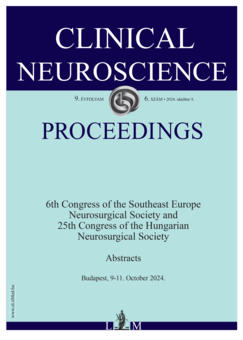Dysphagia from the nurse’s point
FETTER-TENK Szabina1
2024. OKTÓBER 09.
Ideggyógyászati Szemle Proceedings - 2024;9(6)
FETTER-TENK Szabina1
2024. OKTÓBER 09.
Ideggyógyászati Szemle Proceedings - 2024;9(6)
Szöveg nagyítása:

A téma fontosságát mutatja, hogy a dysphagiának súlyos, életveszélyes, akár letális következményei lehetnek: aspirációs pneumonia, fulladás, malnutríció, mikroés makrotápanyag hiányok, testtömegcsökkenés, anorexia, dehidráció, csökkent izomfunkció, depresszió, constipatio, sebgyógyulási zavar, gyakori fertőzések. Az akut fázis alatt bekövetkező mortalitás rizikóját növelő komplikáció. Az előadásom célja azon ismeretek átadása, amivel ez a rizikó csökkenthető. Célom, hogy a hallgató átfogó képet kapjon a dysphagiában szenvedő betegek ellátásáról. A nyelés folyamatának ismertetése, a dysphagia fajtáinak, tüneteinek és terápiás lehetőségek bemutatása. Az ápoló hasznos ápolást segítő tudást sajátíthat el. Bemutatásra kerül a dysphagia szűrés fontossága, lehetőségei. Az Ápolói megfigyelési és szűrési feladatainak összegzése.
Abstract: The importance of this topic is that dysphagia can lead to serious, life-threatening, even fatal consequences: aspiration pneumonia, asphyxy, malnutrition, micro-and macronutrient deficiencies, weight loss, anorexia, dehydration, reduced muscle function, depression, constipation, wound healing disorder, frequent infections. The complications that increasethe risk of mortality occure during the acute phase. The purpose of my presentation is to provide the knowledge that can be used to reduce these risks. My aim is to give a comprehensive picture of the care of patients with dysphagia. Description of the swallowing process, presentation of the types, symptoms and therapeutic options of dysphagia. The nurse can acquire knowledge that useful in care. The importance and possibilities of dysphagia screening are presented. Summary of the nurses’ monitoring and screening tasks.
Ideggyógyászati Szemle Proceedings
Despite evidence based institutional protocols being in place in many countries, aneurysmal subarachnoid hemorrhage (SAH) continues to be a major socio-economic burden with many open questions remaining regarding the optimal management of the affected patients.
Ideggyógyászati Szemle Proceedings
Additive manufacturing has gained significant traction in industrial applications due to its high potential when it comes to manufacturing objects with complex geometry.
Ideggyógyászati Szemle Proceedings
Not only other surgical and robotic fields, but minimally invasive procedures in spine surgery have undergone significant development in recent times. A demand emerged from both surgeons and patients to develop and perform these types of surgeries in order to prevent biomechanical and surgical complications.
Ideggyógyászati Szemle Proceedings
N,N-Dimethyltryptamine is a natural hallucinogen, the active ingredient of the brew called ayahuasca consumed by Amazonian tribes for spiritual purposes.
Ideggyógyászati Szemle Proceedings
Arteriovenous malformation (AVM) is an anomaly of blood vessel formation. Numerous models have been established to understand the nature of AVM.
Hypertonia és Nephrologia
A vizsgálat célja az volt, hogy megtudjuk, hogy a korábban hagyományos módon (egy orvossal és egy OKJ-s ápolóval) működtetett háziorvosi praxis átszervezésével, magasan képzett szakdolgozók bevonásával és a hozzáférés növelésével, hogyan változott a hypertonia diagnosztizálása, a hatóanyagok felírása és a komorbiditások felismerése és kezelése az érintett praxisban. A praxis betegforgalmi és gyógyszerfelírási adatait a 2010–2022 közötti időtartam lekérdezésével vizsgáltuk.
Ideggyógyászati Szemle Proceedings
Additive manufacturing has gained significant traction in industrial applications due to its high potential when it comes to manufacturing objects with complex geometry.
Ideggyógyászati Szemle Proceedings
Pain is a physical experience that is transmitted from sensory nerve cells through the spinal cord to the brain, where the sensation of pain is registered. Each person experiences and endures pain in a different way.
Ideggyógyászati Szemle Proceedings
Coma assesment scales have been developed to facilitate ease of communication between emergency team members and to facilitate ease of clinical assesment for patients with severe impairment of consciousness.
Ideggyógyászati Szemle Proceedings
Cervical spondylotic myelopathy (CSM) is frequently treated surgically to relieve symptoms and to prevent further progression of the pathology. However, long-term outcomes have been seldom reported, especially considering different surgical accesses (anterior, posterior, combined anterior and posterior) in large patient cohorts. In particular, the length of the time period in which improvements can be expected after the treatment has never been extensively investigated.
A tüdőgyulladás előrejelzői dysphagiás stroke-betegekben: Egy török tanulmány
Az Informant Assessment of Geriatric Delirium Scale török verziójának érvényessége és megbízhatósága
1.
2.
3.
4.
5.
Egészségpolitika
Hadiállapotként kezeli és így is reagál a kormány az egészségügy „rendezésére”1.
2.
3.
4.
5.